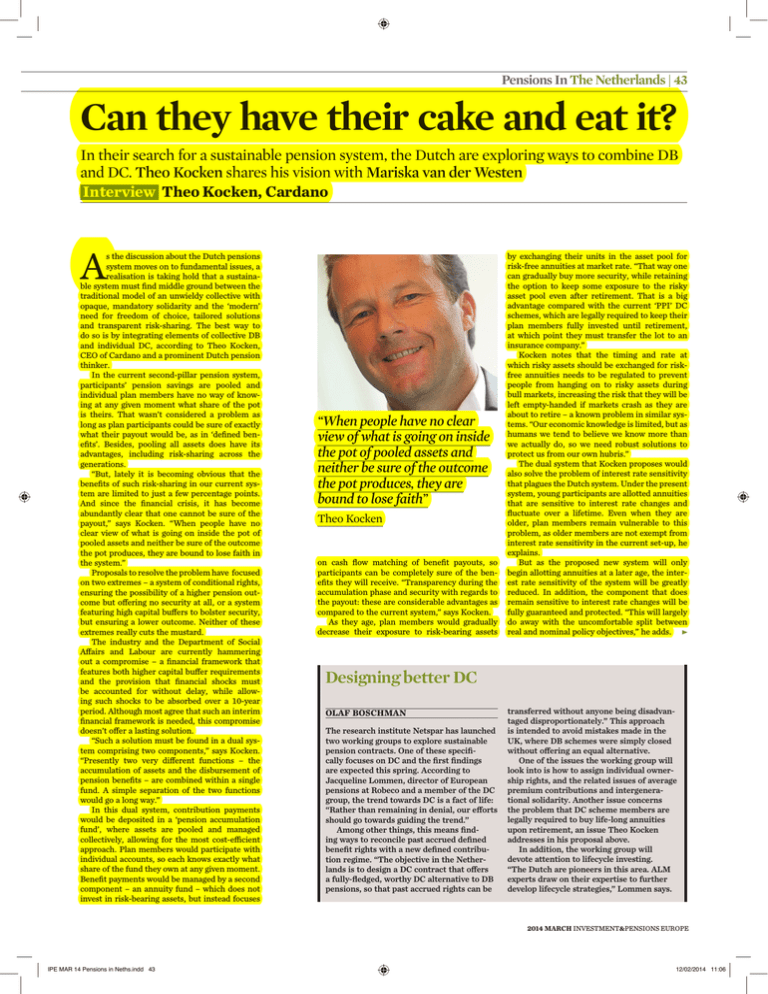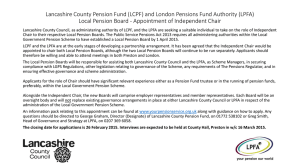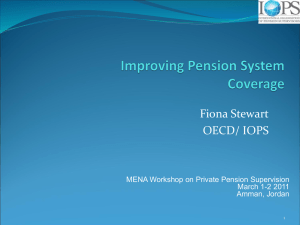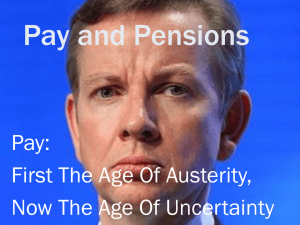VOORWAARDEN DEELNAME KINDERKLEDING
advertisement

Pensions In The Netherlands | 43 Can they have their cake and eat it? In their search for a sustainable pension system, the Dutch are exploring ways to combine DB and DC. Theo Kocken shares his vision with Mariska van der Westen Interview Theo Kocken, Cardano A s the discussion about the Dutch pensions system moves on to fundamental issues, a realisation is taking hold that a sustainable system must find middle ground between the traditional model of an unwieldy collective with opaque, mandatory solidarity and the ‘modern’ need for freedom of choice, tailored solutions and transparent risk-sharing. The best way to do so is by integrating elements of collective DB and individual DC, according to Theo Kocken, CEO of Cardano and a prominent Dutch pension thinker. In the current second-pillar pension system, participants’ pension savings are pooled and individual plan members have no way of knowing at any given moment what share of the pot is theirs. That wasn’t considered a problem as long as plan participants could be sure of exactly what their payout would be, as in ‘defined benefits’. Besides, pooling all assets does have its advantages, including risk-sharing across the generations. “But, lately it is becoming obvious that the benefits of such risk-sharing in our current system are limited to just a few percentage points. And since the financial crisis, it has become abundantly clear that one cannot be sure of the payout,” says Kocken. “When people have no clear view of what is going on inside the pot of pooled assets and neither be sure of the outcome the pot produces, they are bound to lose faith in the system.” Proposals to resolve the problem have focused on two extremes – a system of conditional rights, ensuring the possibility of a higher pension outcome but offering no security at all, or a system featuring high capital buffers to bolster security, but ensuring a lower outcome. Neither of these extremes really cuts the mustard. The industry and the Department of Social Affairs and Labour are currently hammering out a compromise – a financial framework that features both higher capital buffer requirements and the provision that financial shocks must be accounted for without delay, while allowing such shocks to be absorbed over a 10-year period. Although most agree that such an interim financial framework is needed, this compromise doesn’t offer a lasting solution. “Such a solution must be found in a dual system comprising two components,” says Kocken. “Presently two very different functions – the accumulation of assets and the disbursement of pension benefits – are combined within a single fund. A simple separation of the two functions would go a long way.” In this dual system, contribution payments would be deposited in a ‘pension accumulation fund’, where assets are pooled and managed collectively, allowing for the most cost-efficient approach. Plan members would participate with individual accounts, so each knows exactly what share of the fund they own at any given moment. Benefit payments would be managed by a second component – an annuity fund – which does not invest in risk-bearing assets, but instead focuses “When people have no clear view of what is going on inside the pot of pooled assets and neither be sure of the outcome the pot produces, they are bound to lose faith” Theo Kocken on cash flow matching of benefit payouts, so participants can be completely sure of the benefits they will receive. “Transparency during the accumulation phase and security with regards to the payout: these are considerable advantages as compared to the current system,” says Kocken. As they age, plan members would gradually decrease their exposure to risk-bearing assets by exchanging their units in the asset pool for risk-free annuities at market rate. “That way one can gradually buy more security, while retaining the option to keep some exposure to the risky asset pool even after retirement. That is a big advantage compared with the current ‘PPI’ DC schemes, which are legally required to keep their plan members fully invested until retirement, at which point they must transfer the lot to an insurance company.” Kocken notes that the timing and rate at which risky assets should be exchanged for riskfree annuities needs to be regulated to prevent people from hanging on to risky assets during bull markets, increasing the risk that they will be left empty-handed if markets crash as they are about to retire – a known problem in similar systems. “Our economic knowledge is limited, but as humans we tend to believe we know more than we actually do, so we need robust solutions to protect us from our own hubris.” The dual system that Kocken proposes would also solve the problem of interest rate sensitivity that plagues the Dutch system. Under the present system, young participants are allotted annuities that are sensitive to interest rate changes and fluctuate over a lifetime. Even when they are older, plan members remain vulnerable to this problem, as older members are not exempt from interest rate sensitivity in the current set-up, he explains. But as the proposed new system will only begin allotting annuities at a later age, the interest rate sensitivity of the system will be greatly reduced. In addition, the component that does remain sensitive to interest rate changes will be fully guaranteed and protected. “This will largely do away with the uncomfortable split between real and nominal policy objectives,” he adds. • Designing better DC Olaf Boschman The research institute Netspar has launched two working groups to explore sustainable pension contracts. One of these specifically focuses on DC and the first findings are expected this spring. According to Jacqueline Lommen, director of European pensions at Robeco and a member of the DC group, the trend towards DC is a fact of life: “Rather than remaining in denial, our efforts should go towards guiding the trend.” Among other things, this means finding ways to reconcile past accrued defined benefit rights with a new defined contribution regime. “The objective in the Netherlands is to design a DC contract that offers a fully-fledged, worthy DC alternative to DB pensions, so that past accrued rights can be transferred without anyone being disadvantaged disproportionately.” This approach is intended to avoid mistakes made in the UK, where DB schemes were simply closed without offering an equal alternative. One of the issues the working group will look into is how to assign individual ownership rights, and the related issues of average premium contributions and intergenerational solidarity. Another issue concerns the problem that DC scheme members are legally required to buy life-long annuities upon retirement, an issue Theo Kocken addresses in his proposal above. In addition, the working group will devote attention to lifecycle investing. “The Dutch are pioneers in this area. ALM experts draw on their expertise to further develop lifecycle strategies,” Lommen says. 2014 MArch INVESTMENT&PENSIONS EUROPE IPE MAR 14 Pensions in Neths.indd 43 12/02/2014 11:06 The asset pool component of the dual system allows for various forms of risk-sharing including mutual insurance of longevity risks in terms of the risk that one should outlive one’s age cohort. The more tricky variety of longevity risk – the risk that entire age cohorts live longer than expected – cannot be dispatched quite so easily. “Buying insurance from a commercial life insurer is not a realistic option as the insurance market simply isn’t big enough to absorb this risk; besides, the new Solvency II rules would make this a very expensive solution indeed,” says Kocken. “It would be best to leave it up to plan members themselves to absorb this risk, with the possible exception of the elderly. In advanced old age, part of the risk may need to be insured at market rate.” One option would be to design ‘investible’ insurance policies that may be bought by ‘pension accumulation funds’: the risky asset pools that form the first component of the dual system. Although the concept of a dual system isn’t new, there has been discussion about the practical implications, says Kocken: “We are now beginning to get a clear view of how such a system might be implemented. • “We are now beginning to get a clear view of how such a [dual] system might be implemented” Theo Kocken Making the transition from an existing pension system to a new one is never going to be easy, Kocken realises. But the system he proposes has one huge advantage – there will be none of the trouble associated with ‘importing’ past accrued rights into a new regime. “As the current system already serves as an annuity fund, it would suffice to launch an accrual fund to be run alongside it for new accrual. When the switch is flipped, participants in the ‘old’ scheme may be given the option to exchange part of their past accrued annuities to the new accrual fund.” Such an exchange is feasible because accrued rights in the old system can be priced unambiguously at a risk-free interest rate. “Joining the new system should preferably be presented as the default option, so that people would be automatically enrolled unless they explicitly choose to opt out,” he says, adding that a middle-of-the-road option might be added. “As a matter of fact, the changes aren’t really all that extensive. Instead of a single fund in which all manner of opaque things take place, we switch to two funds offering absolute clarity about what everybody will get for their money. That’s all it is.” The role of the Dutch pension funds, will hardly change. “Annuities basically grant the right to a defined pension benefit,” Kocken says. “In that regard, they are essentially insurance contracts that people buy with the money they have made by investing their pension contribution in the pension asset pool. “Considering the size of the system, there is no way to buy all the necessary contracts from the insurance industry. As a nation, we have accumulated €1trn in pension savings. That is simply too much – the insurance industry can barely manage to absorb €10bn. Only pension funds have the wherewithal to meet this kind of demand. Pension funds today fill the role of mutual insurers, and they will continue to.” Not out of danger Olaf Boschman assesses the state of Dutch pension funds Pension Coverage Ratios A t the end of 2013, the average coverage ratio of Dutch pension funds was above the required minimum of 105%. But, more than 30 funds still have to cut pension benefits this year, and the overall health of the industry is in question. In January, PFZW, the €134bn healthcare scheme, decided to grant its participants partial indexation for the first time in four years. The fund’s coverage ratio improved to around 110%, a few percentage points above the minimum of 104.6% required by the regulator DNB. Although the decision is in line with the fund’s policy to increase pensions when the coverage ratio is 105% or above, it was an unwelcome one for DNB. The regulator publicly expressed concern that pension funds would decide to increase pensions too quickly. The objection in short: pension funds that have just recovered from a funding shortfall should not grant indexation and ought to wait for ‘sustainable recovery’ as indexation could harm their nascent recovery and it is wiser to build up a buffer first. Some pension funds that granted indexation back in 2009 had to cut rights later, the DNB warned. The regulator doesn’t mention funds by name, but ABP was one of the funds that did so. The €293bn civil service scheme gave its members partial indexation back in 2009 and then, last year, had to cut rights. The DNB declines to state a coverage ratio that qualifies as solid or sustainable, but the concern indicates that the sector is far from healthy. Frank Driessen, actuary and principal at Aon Hewitt, says the DNB has correctly expressed “For pension funds with a coverage ratio below 110%, it is best to wait with indexation. “They are exposed to equity risk. A stock market shock has a direct impact on the coverage ratio” Frank Driessen according to Casper van Ewijk, director of Netspar, the Dutch network for studies on pensions, ageing and retirement, and the coverage ratio is only one of the symptoms. It only reflects nominal pension accrual and hence distorts the view Ophélie Mortier, Petercam SRI Coordinator “TOMORROW’S CHALLENGES ARE TODAY’S OPPORTUNITIES.” PROVEN AND CONSISTENT TRACK RECORD Petercam Composite: Euroland Government Bonds Sustainable Composite benchmark 145 140 135 130 125 120 115 110 105 100 95 1/ 01 /0 9 1/ 04 /0 9 1/ 07 /0 9 1/ 10 /0 9 1/ 01 /1 0 1/ 04 /1 0 1/ 07 /1 0 1/ 10 /1 0 1/ 01 /1 1 1/ 04 /1 1 1/ 07 /1 1 1/ 10 /1 1 1/ 01 /1 2 1/ 04 /1 2 1/ 07 /1 2 1/ 10 /1 2 1/ 01 /1 3 1/ 04 /1 3 1/ 07 /1 3 1/ 10 /1 3 1/ 01 /1 4 44 | Pensions In The Netherlands its concern. “For pension funds with a coverage ratio below 110%, it is best to wait with indexation,” he says, pointing out that funds don’t have the capacity to absorb shocks. “They are exposed to equity risk. A stock market shock has a direct impact on the coverage ratio.” Shortfalls this year will be transferred to the new financial assessment framework (FTK) that is planned to come into effect on 1 January 2015. “Funds that grant indexation now surrender financial capacity they may need later this year,” Driessens adds. The Dutch pension system is in danger, ■ ANNUALISED PERFORMANCE OF THE COMPOSITE +5.28% ■ ANNUALISED PERFORMANCE OF THE COMPOSITE BENCHMARK +4.15% GIPS compliant returns, gross of fees, in EUR as at 31/12/2013 Composite return 1 year annualized (-1.34% vs. + 2.38% for the composite benchmark) Composite return 3 years annualized (+4.35% vs. +5.10% for the composite benchmark) Z[[\ZV*XS@/QSU6]UAZ[PS/.D/,%"/P]AQ]X*^S/ !"#$%& Cumulative performance for the composite on 5 years (+29.32% vs. +22.53% for the composite Z[[\ZV*XS@/QSU6]UAZ[PS/]6/^_S/P]AQ]X*^S/!S[P_AZU`/ !'#("& benchmark) W*QX/$.&+B-'#,/(",7(#H:/G(.HH/.D/D""H:/-#/S\U/'H/',/1434838241 P.&+.H-,"/(",7(#/4/C"'(/'##7'B-a"0/FL4E1=;/KHE/b8E19;/D.(/,%"/$.&+.H-,"/Y"#$%&'()I P.&+.H-,"/(",7(#/1/C"'(H/'##7'B-a"0/Fb=E1N;/KHE/bNE42;/D.(/,%"/$.&+.H-,"/Y"#$%&'()I P7&7B',-K"/+"(D.(&'#$"/D.(/,%"/$.&+.H-,"/.#/N/C"'(H/Fb8<E18;/KHE/b88EN1;/D.(/,%"/$.&+.H-,"/Y"#$%&'()I http://iamexpertises.petercam.com +32 (0)2 229 62 58 The GIPS firm, Petercam Institutional Asset Management, claims compliance with the Global Investment P SA responsible for the discretionary management of institutional mandates and investment funds. The com portfolios that are mainly invested in highest quality fixed-income securities issued by OECD-countries and pri The compliant presentation and the firm’s list of composite descriptions can be obtained on the Petercam web INVESTMENT&PENSIONS EUROPE MArch 2014 IPE MAR 14 Pensions in Neths.indd 44 12/02/2014 11:12






